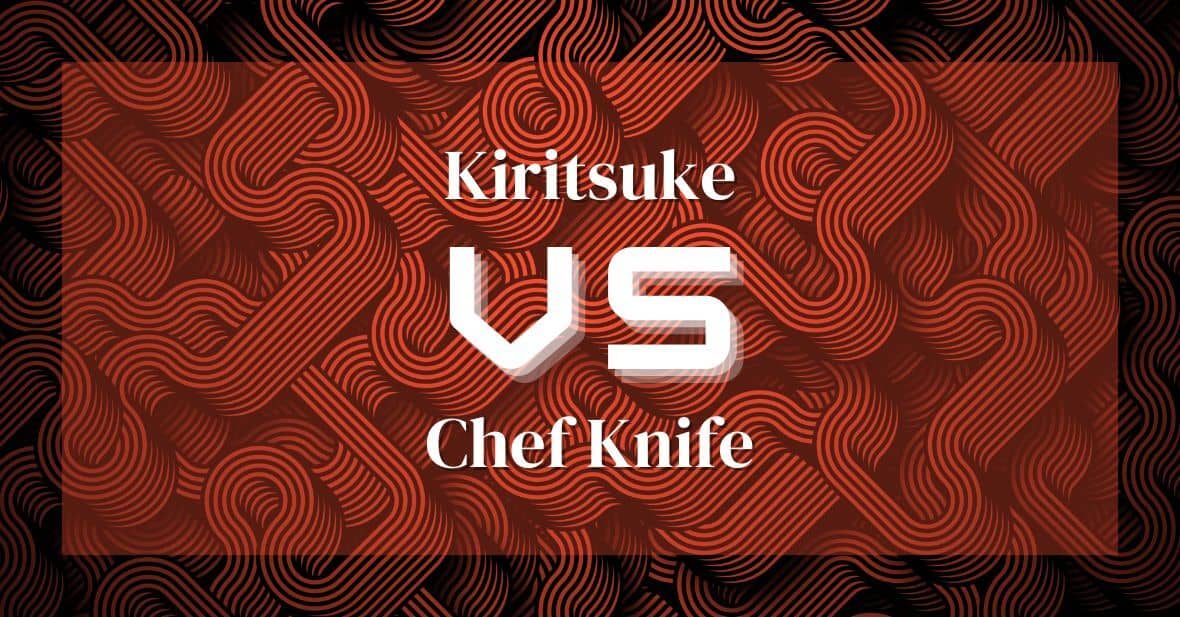Kiritsuke vs Chef Knife: Which Knife Holds the Power?
Are you torn between two knives in the kitchen? It’s a classic case of rock and hard place: Kiritsuke vs chef knife. Picking between them is like splitting hairs – they both have their pros and cons, and choosing one over the other can be a tricky decision.
But don’t worry, we’re here to help you pick the right tool for your culinary needs! Think of us as your culinary compass guiding you through the differences between these two versatile blades.
So grab your cutting board, sharpen your knives, and let’s get slicing!
Design of the Kiritsuke Knife
The design of this particular blade is one that exudes sophistication and finesse. The kiritsuke knife is a hybrid between the traditional Japanese Usuba-Kamagata blade shape and the Western chef’s knife. It has a single-edged blade with an angled tip, making it suitable for slicing vegetables as well as for delicate work such as garnishing.
When compared to a chef’s knife, the kiritsuke offers superior sharpness due to its thinner edge and harder steel construction. Its handle design allows for better control when executing precision cuts or intricate tasks like peeling fruits.
This combination makes the kiritsuke an ideal tool for any professional kitchen in need of accurate and efficient cutting solutions.
Construction of the Kiritsuke Knife
It’s a long, single-edged blade crafted for precision slicing and delicate work – perfect for intricate veggie cuts and detailed fish filleting.
But what makes the Kiritsuke knife so special?
Well, it all comes down to the construction of this unique kitchen tool.
At its core, the blade is made of high-quality steel that can be sharpened to a razor-like edge with the right sharpening techniques.
This allows you to slice through food without leaving any nasty jagged edges behind!
The handle is usually made from wood or plastic, depending on your preference, so you can easily maintain control over your cutting movements.
Plus, some models even have a bolster that gives you extra grip and protection from accidental slips!
All in all, the Kiritsuke knife is one handy kitchen tool – just make sure to take good care of it by using proper sharpening techniques and choosing quality blade materials.
Uses of the Kiritsuke Knife
You’ll be able to slice, dice, and fillet like a pro with the Kiritsuke knife in your hand! The Kiritsuke knife is traditionally used in Japanese cuisine, with its length of around 270mm. It’s longer than most chef’s knives, so you can easily cut larger ingredients such as melons and squash.
The blade tapers from a broad top edge to a point at the tip which helps create thin slices for sashimi dishes. Its unique shape also makes it perfect for chopping vegetables into uniform pieces.
Plus, its long blade length also makes it ideal for cutting large roasts and fish without having to reposition your hands on the handle. You’ll definitely find yourself reaching for this essential culinary tool when prepping meals in the kitchen!
Design of the Chef Knife
With its tapered blade and curved handle, the chef knife is designed to give you maximum control over your cutting tasks! The chef knife offers a unique design that allows for precision cutting, comfortable handling, and easy sharpening techniques.
The sharpened edge of the blade makes it easy to cut through tough ingredients with precision. The curved handle fits comfortably in your hand, allowing you to work quickly and efficiently. With proper care and maintenance, the chef knife can be kept sharp for years of use.
Whether you’re slicing vegetables or chopping herbs, the chef knife is an essential tool in any kitchen. Its versatile design makes it perfect for tackling any task with ease and accuracy. Plus, its sharpening techniques make it easy to keep your blade in top condition, so you can continue exploring alternatives without worrying about dulling your knife!
Construction of the Chef Knife
Crafting a chef knife requires artistry and attention to detail, as it’s a delicate balance between form and function. It’s much like an artist balancing their palette of colors.
The construction of the chef knife is no small feat. It must be made from high-quality materials that can withstand the rigors of daily use.
Cleaning techniques are essential for proper care maintenance. They help keep the blade sharp and free from rust or corrosion.
With regular cleaning and oiling, your chef knife will remain in top condition for years to come. And with its unique design, you’ll be sure to make a statement in any kitchen!
Conclusion
You’ve made a tough decision – you must choose between the kiritsuke knife and the chef knife. Each of these knives has its own unique characteristics that make it stand out from the other. But which one is right for you?
The kiritsuke knife symbolizes precision and power, while the chef knife is a symbol of versatility and dependability. Ultimately, it’s up to you to decide which of these two blades best meets your needs.
But no matter which one you choose, both will provide an excellent tool that can help complete any task with ease.
Frequently Asked Questions
What Is The Difference Between A Kiritsuke And A Chef Knife?
Are you looking for the perfect knife to add to your kitchen arsenal? Look no further than a kiritsuke and a chef knife!
Both of these knives have Japanese origins, but they differ in blade design. The kiritsuke is a multi-purpose knife with an angled tip that makes it great for slicing, dicing, and chopping.
On the other hand, the chef knife has a curved blade that’s ideal for rocking back and forth when mincing or chopping ingredients.
So if you’re looking for something versatile or something more specialized, either one of these knives will do the trick!
What Is The Best Way To Sharpen A Kiritsuke Knife?
Sharpening your kiritsuke knife is an art form, and it requires patience and precision. You’ll need to take the time to master the techniques of blade maintenance if you want to keep your kiritsuke in top condition.
Start by honing the blade with a sharpening stone or steel rod. Then use a whetstone for finer sharpening. Make sure you’re using light strokes and keeping the angle consistent as you sharpen.
Finally, finish off with a leather strop for that extra edge. With practice and dedication, you can become an expert at sharpening your kiritsuke knife!
Are Kiritsuke Knives Suitable For Beginner Cooks?
When it comes to selecting a knife for beginner cooks, the kiritsuke is an excellent choice. It’s versatile and easy to maintain, and its unique shape also makes it a great conversation starter in the kitchen! With proper care and maintenance, you can ensure that your kiritsuke will last for years to come.
So if you’re looking for a knife that’s both stylish and practical, then the kiritsuke is definitely worth considering.
How Do Kiritsuke Knives Compare In Price To Chef Knives?
You’re looking for a great kitchen knife that doesn’t break the bank, and you want to know how kiritsuke knives compare in price to chef knives.
Well, let’s look at the blade of your dreams from an economical perspective. A kiritsuke knife is often seen as a symbol of skill and precision due to its multi-purpose use in the culinary world. While they can be pricier than regular chef knives, the cost comparison is not necessarily always so stark – depending on quality and brand, it might just be a few dollars more.
So if you desire a 3-in-1 tool that will last you for years with proper care, then investing in a good quality kiritsuke could be worth every penny!
Are Kiritsuke Knives More Durable Than Chef Knives?
When it comes to durability, many people debate whether a kiritsuke knife or a chef knife is the better option. The kiritsuke’s single beveled edge and slightly curved tip make it more resilient than a chef knife with its double-beveled edge and pointed tip. The handle shape of a kiritsuke also adds to its strength. Its longer handle allows for added control when cutting through tough materials, making it much less likely to break under pressure.
So if you’re looking for something that’ll really stand the test of time, then a kiritsuke might just be the perfect choice!
Additional Resources
19 Types of Kitchen Knives & Their Uses
Western Style Knives 101 | A Comprehensive Introduction to the Basics
The Art of the Slice: A Dive into Japanese Knife Types
What Is a Chef Knife? Your Ultimate Guide to This Essential Kitchen Tool
What is a Kiritsuke Knife Used For? Unlocking the Mystery
Forging Culinary Excellence: The Best Steel For Kitchen Knives

